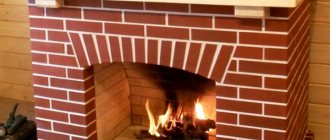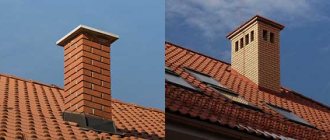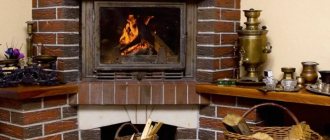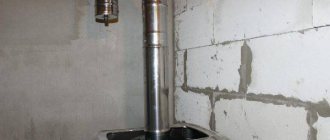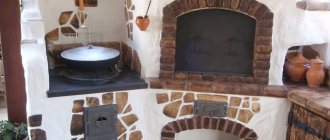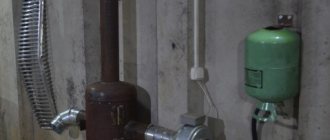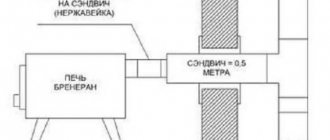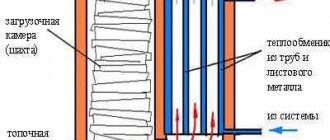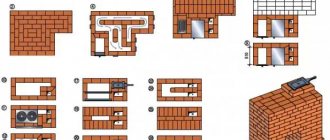Welcome to our portal!
A fireplace is associated with warmth and comfort, and therefore is a desirable attribute of any private home. However, the main function of a fireplace is not to decorate the home, but to heat it. And this imposes a number of requirements on their arrangement, and the key is to install an effective smoke removal system.
A chimney for a fireplace is another topic in our issue. The focus is on compliance with building codes and safe operation, aesthetics and practicality. We will help you avoid the most common mistakes and give recommendations from stove and fireplace craftsmen.
What is it and what is it for?
A chimney is a system of pipe channels designed to discharge smoke and gases generated during fuel combustion into the atmosphere.
Basic requirements for chimneys:
- resistance to high temperatures (over 500⁰C);
- formation of sufficient traction force;
- complete tightness;
- resistance to moisture formed inside the system as a result of condensation;
- resistance to the effects of carbon and sulfuric acid formed inside the circuit as a result of the chemical reaction of water vapor and exhaust gases (soot);
- ensuring structural stability;
- compliance with fire safety standards.
Stages of masonry, choice of mortar and brick
Installation of a mounted chimney is carried out according to the following algorithm:
- The necessary parameters are calculated, bricks, mortar and the necessary tools are prepared.
- The first row is laid around the furnace outlet opening.
- The 1st row is checked with a building level for compliance with the horizontal and vertical planes.
- The subsequent rows are being installed.
- After laying 3-4 rows, the channel is cleared of excess mortar on the walls.
- Before the 3rd row reaches the overlap, a fluff is formed while maintaining the internal cross-section of the channel.
- The laying of rows of fluff continues to a level slightly above the floor of the attic.
- Next, the laying of the riser continues along the original perimeter.
- When the roof masonry is reached, the formation of the otter begins.
- The laying of otter rows continues until its bricks go beyond the roof level located closer to the ridge.
Installation of a chimney on the roof Source legkovmeste.ru
- Afterwards, the laying of the finishing part of the chimney begins to a given height with a protrusion of bricks at the cut - to form the head.
- Finally, a cap is installed to protect against precipitation.
To install a stove chimney, a special masonry mortar is used - ordinary construction mortar will not work. Its composition depends on the location of the pipe section:
- From the pipe to the ceiling in the room, a classic clay-sand mixture is used - similar to that used for laying the stove itself. As a rule, 3 parts clay and 1 part sand are used for preparation.
How the chimney works
Despite the fact that the structure of smoke channels made of different materials has its own characteristics, in general they represent a vertical, inclined or horizontal sealed shaft adjacent to the combustion chamber of a heat-generating unit (fireplace, stove or boiler).
The cross-section of the pipeline can be round, oval, rectangular and even polygonal. Height – at least 5 meters.
Each wiring diagram is individual and is selected depending on the specifics of the building and the fireplace model.
Calculation of basic parameters
At the design stage, it is necessary to determine the height of the chimney and the cross-sectional dimensions of the smoke exhaust duct. The task of the calculation is to ensure optimal traction force. It must be sufficient to ensure that the required amount of air enters the firebox and all combustion products are removed in full, and at the same time not too large so that hot gases have time to give up their heat.
Height
The height of the chimney must be selected taking into account the following requirements:
- The minimum height difference between the grate and the top of the head is 5 m.
- If the roof is covered with flammable material, for example, bitumen shingles, the chimney head should rise above it by at least 1.5 m.
- For roofs with non-combustible coating, the minimum distance to the top is 0.5 m.
The ridge of a pitched roof or a flat parapet in windy weather should not create support above the chimney. To do this you need to adhere to the following rules:
- if the pipe is located closer than 1.5 m in relation to the ridge or parapet, then it should rise above this element by at least 0.5 m;
- when removed from the ridge or parapet at a distance of 1.5 to 3 m, the head of the pipe can be at the same height as this element;
- at a distance of more than 3 m, the top of the head can be placed below the ridge, at the height of an inclined line drawn through it with an angle of 10 degrees relative to the horizontal.
If there is a higher building near the house, then the chimney should be erected 0.5 m above its roof.
The brick chimney is very neat and fits into any exterior
Section dimensions
If a stove or boiler is connected to the chimney, then the cross-sectional dimensions should be determined depending on the power of the heat generator:
- up to 3.5 kW: the channel is made the size of half a brick - 140x140 mm;
- from 3.5 to 5.2 kW: 140x200 mm;
- from 5.2 to 7 kW: 200x270 mm;
- over 7 kW: in two bricks - 270x270 mm.
The power of factory-made heat generators is indicated in the passport. If the stove or boiler is homemade, you have to determine this parameter yourself. The calculation is carried out according to the formula:
W = Vt * 0.63 * * 0.8 * E / t,
Where:
- W—heat generator power, kW;
- Vt—furnace volume, m3;
- 0.63 - average furnace load factor;
- 0.8 - average coefficient showing what part of the fuel burns completely;
- E is the calorific value of the fuel, kW*h/m3;
- T is the burning time of one fuel load, hours.
The chimney can always be decorated if desired
The calorific value E depends on the type of wood and its moisture content. The average values are:
- for poplar: at a humidity of 12% E - 1856 kWh/cubic meter. m, with humidity 25 and 50% - 1448 and 636 kWh/m3, respectively;
- for spruce: at humidity 12, 25 and 50%, respectively, 2088, 1629 and 715 kWh/m3;
- for pine: respectively, 2413, 1882 and 826 kW*h/m3;
- for birch: respectively, 3016, 2352 and 1033 kW*h/m3;
- for oak: respectively, 3758, 2932 and 1287 kW*h/m3.
For fireplaces, the calculation is slightly different. Here the cross-sectional area of the chimney depends on the size of the firebox window: F = k * A.
Where:
- F is the cross-sectional area of the smoke exhaust channel, cm2;
- K is the proportionality coefficient, depending on the height of the chimney and the shape of its cross-section;
- A is the area of the firebox window, cm2.
The coefficient K is equal to the following values:
- with a chimney height of 5 m: for a round section - 0.112, for a square section - 0.124, for a rectangular section - 0.132;
- 6 m: 0.105, 0.116, 0.123;
- 7 m: 0.1, 0.11, 0.117;
- 8 m: 0.095, 0.105, 0.112;
- 9 m: 0.091, 0.101, 0.106;
- 10 m: 0.087, 0.097, 0.102;
- 11 m: 0.089, 0.094, 0.098.
For intermediate height values, the K coefficient can be determined using a special graph.
This graph allows you to determine the K coefficient for intermediate values of pipe height
They tend to make the actual dimensions of the smoke exhaust duct close to the calculated ones. But they are selected taking into account the standard sizes of bricks, blocks or cylindrical parts.
Principle of operation
- The fuel placed in the firebox of a fireplace (stove, boiler) is ignited, as a result, the process of generating heat starts, and with it smoke (soot, ash and other aggressive chemical compounds harmful to human health).
- The temperature of the combustion products is about 500⁰C, which means they become lighter and rush up the shaft. The influx of cold air starts the process of natural convection, increasing the traction force and thereby displacing combustion products outside.
- Oxygen-rich air naturally supports fuel combustion.
Advantages and disadvantages
The main advantages of a brick chimney:
- The ability of the material to retain heat for a long time. This reduces the risk of condensation, which significantly extends service life.
- Classic style. Thanks to this, the chimney is combined with a wooden, brick, concrete, frame house.
- High strength.
- Low cost of material , especially in comparison with modern analogues made using sandwich technologies.
Brick is the most affordable material for laying a chimney Source oboiman.ru
- Fire safety. The passing gases do not have time to heat the chimney to a critical level.
However, this design is not without several significant drawbacks:
- The internal rough surface is an effective soot collector. Therefore, without regular cleaning, the chimney will simply stop functioning.
- Laying a brick chimney pipe is quite complex both technically and physically - delivering heavy material to the roof, preparing mortar, etc. procedures.
- Large weight of the structure - it is necessary to create a powerful foundation.
- Not the best aerodynamic performance of square and rectangular strokes with a rough surface, for example, in comparison with smooth round metal counterparts.
On a note! The average service life of a brick chimney is 10 years. However, with regular cleaning, care and proper protection, it can be extended several times.
Timely cleaning is the key to successful chimney operation Source mybuilding.tips
See also: https://m-strana.ru/brands/remont-krovli/
Traction force
The functioning of the chimney is based on the draft effect, due to which masses of gases move in the direction from the inlet of the pipe to the outlet due to the influx of fresh air from outside. Traction force is a variable quantity; it is influenced by weather conditions: wind direction and speed, outside air temperature, as well as the state of ventilation in the room (fresh air flow).
Signs of traction problems:
- difficulties in lighting a fireplace;
- low burning flame;
- smoke in the room.
To check the smoke shaft for the presence of natural draft, bring a lit candle or match to the firebox of a non-working fireplace:
- the tilt of the flame towards the smoke exhaust channel indicates the correct operation of the circuit;
- if the flame is level, there is no draft;
- the tilt of the flame towards the room warns of the backdraft effect.
It is impossible to operate the fireplace in the absence or reverse draft. Too much thrust leads to a decrease in thermal efficiency and unnecessary waste of fuel.
Causes of traction problems:
- incorrect configuration of the smoke channel;
- its insufficient height or incorrectly selected section;
- chimney blockage;
- lack of fresh air flow from the street.
Conditions for normal functioning of the chimney:
- maximum verticality of the contour;
- smoothness and tightness of walls;
- regular maintenance and cleaning of the smoke exhaust shaft;
- installing a deflector above the pipe;
- ensuring the flow of fresh air (the presence of a separate adjustable air duct from the street or setting window fittings to ventilation mode during operation of the fireplace);
- installation of equipment to provide forced draft.
Internal section of the chimney
Fireplace chimney.
There is nothing better than the usual cylindrical shape for constructing a chimney. Considering the uneven upward movement of combustion products, which move in a circle along the axis of the chimney, a cylinder seems to be the most acceptable shape, which is capable of providing the strongest draft. In a rectangular pipe, turbulence will form at the corner parts, which will prevent the normal level of draft. However, it is noted that a rectangular pipe can be successfully used with thermal devices that do not require high draft.
These fireplaces and stoves include options that heat rooms with wood. If, for example, the cross-section of the chimney is rectangular and the smoke circulation in it is properly arranged, then this will allow maintaining the temperature to which the heating device was heated. In comparison with pipes with a round cross-section, this looks ideal, since all the heat will evaporate from a cylindrical chimney quite quickly. New generation fireplaces are increasingly equipped with cylindrical chimneys. They operate using a fast heating system - when the system heats up to the set temperature, the boiler will automatically turn off and go into standby mode, thus saving energy.
Types and designs
Based on their location, chimneys are divided into external and internal.
- Placing a chimney inside a heated room and its outlet through the roof.
This method allows you to naturally increase draft, protect the chimney from freezing and reduce the heat loss coefficient. In addition, the absence of connection to an external wall makes it possible to install a fireplace in any part of the building, maintaining maximum verticality, and the gradual cooling of the air mass prevents the formation of condensation inside the circuit. However, the location of the chimney pipe inside the house, firstly, takes up useful space. Secondly, it does not always look aesthetically pleasing (except when it is made of brick). Thirdly, if there are errors in the arrangement of the smoke exhaust duct or improper care of it, the likelihood of fires increases.
- External placement of the chimney pipe.
The heating device is placed near one of the facade walls, and the pipe itself is carried out through this wall. This concept allows you to increase the usable area of your home, which is especially important for small house sizes. However, the pipeline circuit requires careful insulation, which still does not solve the problem of condensation formation in it, the cause of which is a significant difference in internal and external temperatures. The negative point is the inevitability of laying part of the pipeline in a horizontal position, which reduces draft and makes it difficult to clear the main path. The location of the chimney duct on the street significantly reduces the risk of fires and is therefore considered safer. In addition, it is easier to equip and repair.
According to the type of design, chimney circuits are divided into:
- radical, in which the chimney duct is arranged on a separate foundation and attached to the fireplace in a vertical position on the side.
- mounted ones, installed above the fireplace and being its natural extension.
- wall, when the chimney is placed directly in the internal or facade wall of a private house or goes outside through it.
For the construction of chimney shafts, a variety of materials are used that meet the following requirements:
- high coefficient of heat resistance and fire resistance;
- low thermal conductivity;
- inertness to aggressive chemical compounds formed from combustion products;
- resistance to water and corrosive processes.
The following types of materials meet the above conditions:
- Brick.
The material is available and traditionally used for the construction of stoves, fireplaces and chimneys. However, not every type of brick is used for this purpose, but only solid clay brick, which has gone through the pre-firing stage, due to which it is able to stably withstand high temperatures. If all construction technologies are followed and proper care is taken, a brick chimney will last more than 100 years.
Special requirements are also imposed on the cement mortar used to lay the bricks. It should be a mixture of sand, cement and lime in a ratio of 5:2:1. It is this solution that can provide a tight, airtight connection that is resistant to heat. Because the smoothness of the inner surface of the pipe is one of the primary requirements for the arrangement of the chimney duct; the laid mortar should not protrude inward from the seam joints. However, the surface of the brick itself has a certain roughness, which causes ash and soot to settle on the walls, leading over time to the appearance of congestion.
The significant weight of the structure requires the pouring of a separate deep foundation, which means that the construction of a brick chimney must be planned at the stage of preparing the house construction project.
- Ceramics.
Ideal for wood-burning and other solid fuel fireplaces. It withstands high temperatures (up to 1000⁰C) and the aggressive influence of chemical elements. Ceramics heats up quickly and cools down slowly, which allows you to significantly save energy resources when heating your home. The ideally smooth surface of the internal walls prevents combustion waste from accumulating inside. Service life – 30-50 years.
The variety of shaped elements allows you to implement almost any design solution. In addition, pipes alone are not enough; you will need a special assembly adhesive, with which the elements are assembled and sealed, as well as the construction of a heat-insulating circuit made of heat-resistant materials. Manufacturers suggest using specially designed lightweight aerated concrete blocks as a thermal insulation circuit, often additionally equipped with a thermal insulation layer.
Disadvantages include the heavy weight of the structure, which requires the installation of a separate foundation under the chimney, and the high cost of the structure. When using lightweight concrete blocks, there is no need for a traditional foundation; it can be completely replaced with a monolithic foundation made of a concrete pipe.
- Metal and steel.
Chimneys made of heat-resistant anti-corrosion steel are used only at combustion temperatures of no more than 400⁰C. They are much cheaper and lighter than their brick and ceramic counterparts, which eliminates the need to build a foundation site for them. Their service life ranges from 15-20 years.
Metal pipes are manufactured in factories in separate sections, from which the circuit of the desired configuration is then assembled. Depending on the type and rigidity of the metal, they can be self-supporting or require additional fixation to other supporting structures (walls, trusses, etc.), made of one type of metal or several (stainless steel inside, aluminum outside). The main advantage of steel chimney ducts is ease of installation and connection. In addition, they can be installed either independently or in combination with brickwork, performing the so-called lining.
Steel chimneys are classified into 2 groups: simple without thermal insulation and sandwich pipes, the design of which includes a heat-insulating layer. The coaxial design (“pipe in pipe” + thermal insulation) is the most popular.
- Glass.
Durable tempered glass is not the most practical solution for a chimney, and is most often used solely for decorative purposes. As advantages, it is worth noting the absolute inertness to the chemical effects of combustion products and the ideal evenness of the walls, which prevents the formation of soot build-ups inside the circuit. However, you have to wash visible areas quite often, since small deposits of soot still form, which negates the aesthetic appeal of such a chimney.
The complexity of assembly in terms of ensuring tight connections is one of the main disadvantages of this type of design. In addition, glass is prone to condensation accumulation and requires work on thermal insulation of the circuit. All this, combined with its high cost, makes glass not the most popular material for arranging chimney lines, assigning it the role of a decorative element only in a small area of the contour.
A number of technical documents allow the use of asbestos-cement pipes for the installation of chimneys. However, experts do not recommend using them for this purpose, because they are characterized by an insufficient level of resistance to high temperatures (no more than 300⁰C).
On an industrial scale, monolithic concrete is used, but for private households this method is considered too labor-intensive.
Prohibited for use:
- tree;
- silicate and hollow bricks;
- clay;
- galvanized sheet.
Phased construction of the pipe
There are clear instructions for constructing a chimney. When constructing yourself, it is recommended to follow all the rules and use pre-prepared diagrams.
Preparatory stage
To perform the work efficiently, careful preparation is necessary. At this stage, you should familiarize yourself with possible drawings and diagrams of brick structures and choose the best option. At this stage, you can reflect all the characteristics of the future system in the drawing. The design of a brick chimney for a fireplace has some features that depend on the type of stove itself. In models heated with wood, there is enough brickwork. But for models connected to gas, a metal pipe should be placed inside the device.
You will need at least a sheet of steel
Preliminary work includes laying a rectangular foundation. It should not exceed 40 centimeters in height. It is made no more than 20 centimeters in width. Made from concrete or brick using any of the available methods:
- The formwork is installed according to the required dimensions, and the finished concrete composition is poured into it.
- According to preliminary markings, solid fire-resistant bricks are laid. Usually the brand “M200” and other products with higher performance are used.
For subsequent installation work, equipment preparation will be required . When installing a chimney for a fireplace you will need:
- fire brick;
- special solution;
- tool;
- materials for thermal insulation;
- sheet steel;
- power tool.
The solution is prepared from cement, water, fine river sand, and clay. It is advisable to include all the necessary devices in the list of working tools: trowel, plumb line, level, etc.
Main stage of work
Before laying bricks, you should determine the cross-section of the future chimney. It should be taken into account that the smoke will move in a spiral as it moves towards the exit. Due to this feature, it is recommended to make round channels. But it is very difficult to build such a structure from brick.
It makes more sense to lay out a square chimney, the size of which depends on the fireplace portal. A portal is an external design with a recess for installing the main device - a fireplace. The external device can be open or closed.
A closed-type portal is laid out in the shape of a rectangle 15x25 cm. An open portal has the shape of a square with a size of 25x25 cm. The laying begins with the arrangement of a mounted pipe and moves from top to bottom. It is imperative to adhere to the dressing of seams between rows. They should not exceed 1.5 cm in thickness. These parameters must be maintained throughout the entire working process.
The mounted pipe is erected up to the ceiling on the roof (a distance of at least 6 rows must be maintained from the ceiling). The surface inside the structure is plastered so that smoke can move out freely. At the same time, you should not lay it in a thick layer, narrowing the passage.
If a chimney is built near a wall, metal pins are used for additional fastening. One end is fixed in the wall, the other in the brickwork at a distance of 30 cm from each other.
After laying the last row, check the vertical and horizontal of the building. Only after this is it permissible to proceed to the most difficult moment in construction - laying the fluff, seal and riser.
It is possible to make a chimney correctly for a fireplace with the safest installation of the fluff. The walls of this device must be at least one brick thick in length. By moving the bricks by ¼ in each row, the structure is gradually expanded.
To simplify the work, in some cases a concrete box is used instead of brickwork. The internal space of the device is filled with sand, pebbles, and expanded clay. It is erected around the chimney pipe as follows:
- They install formwork that rises 10 cm above the ceiling. Its fastenings must be reliable. The presence of cracks in the structure should also be excluded.
- To facilitate dismantling work, the formwork is covered from the inside with a mixture of sand and clay. In this case, the boards will not stick to the concrete.
- After completing the preparatory work, they proceed to reinforcement. It looks like a rigid connection of brickwork with metal rods.
- It is better to make the working solution from high-quality cement. Filler and sand are added to it, mixed and poured. The reinforcement must be hidden under cement.
- The formwork is dismantled after the cement has completely dried.
Work should be done diligently. After removing the formwork, a flat surface should remain. This is necessary for high-quality and easy brick laying of the fluff.
For maximum protection of the ceiling, it is necessary to make a steel edging. Glass wool, previously soaked in a clay solution, is placed in the gap in the ceiling. Insulating material is laid on the sides.
When the fluff is ready, the construction of the riser continues. Its size is similar to the mounted pipe. The only difference is plastering, which is carried out on both sides at once: internal and external. To preserve the integrity of the pipe in winter, it is wrapped in heat-resistant insulating raw materials.
A roof is mounted on the roof and the pipe is slightly expanded. Before installing the roof and waterproofing, a galvanized metal casing is made around the perimeter of the pipe. It will protect the roof from the flow of natural precipitation into the room.
Final phase
At the last stage of construction, the neck of the structure is equipped. Its structure is similar to a riser. Its height depends on the degree of distance from the ridge. Next, they begin to build the head. Its structure is similar to fluff. Upon completion of the work, the craftsmen advise installing a weather vane and cap.
Which fireplace is better
The choice of material for the smoke exhaust duct should be based on the technical characteristics of the fireplace and the fuel on which it will operate:
- for solid fuel fireplaces, pipes made of brick or ceramics are best suited;
- for gas models, priority can be given to coaxial steel pipes.
A few recommendations for choosing the type of structure:
- It is best to install the chimney inside the house, where operational loads on it are minimized. In addition, this solution will allow the heat coming from the chimney shaft to be generated into useful energy for heating the home. However, it should be understood that this is the most labor-intensive process and sometimes not feasible in the conditions of an already constructed building.
- Installation of a fireplace with a smoke circuit exiting to the street is possible at any stage of construction and even upon its completion.
- If the chimney shaft is located internally, it is best to allocate a place for it in the middle of the room or on one of the internal walls. This will keep more heat inside the room and reduce the likelihood of condensation forming inside the circuit.
- When choosing one of the facade walls, you should take care of careful insulation of the structure on the street side. To do this, either the brickwork is thickened or special fireproof materials are used.
- The cylinder is the most optimal shape of the chimney channel, providing maximum draft due to the movement of the flow in a spiral. A similar effect is typical for oval, square and rectangular shapes, but at a slower rate. In addition, soot will inevitably accumulate in the corners, which further impairs traction.
Advantages and disadvantages
Listing the positive aspects of a brick chimney, it is worth highlighting it:
- heat capacity and thermal conductivity;
- aesthetics;
- durability;
- low cost.
One can only add to the disadvantages:
- complexity of masonry. To do this, you need to have certain skills in construction, have some free time and strictly follow all technological processes;
- large weight putting a load on the heating device.
If the height of the chimney exceeds 5 m, it is necessary to make its own foundation for it.
Make it yourself or order it
At first glance, there is nothing complicated about installing a chimney with your own hands, however, this is not entirely true. First of all, it should be remembered that the structure must be absolutely safe, which means it must be durable, airtight and with good traction force. And this will require from the “stove-maker”, at a minimum, relevant knowledge and thoroughness, and, at a maximum, certain experience and skills.
On the other hand, entrusting such a responsible job to a builder whose professionalism and integrity you doubt is not the most reasonable decision. After all, poorly done work can subsequently result in a fire or carbon monoxide poisoning.
Therefore, preference should be given only to trusted construction companies or take on the work yourself.
But to independently implement the project, you will need to make every effort:
- study a number of building rules and technical information about the heating device;
- make the necessary calculations;
- carry out construction and installation systematically, often at length and with special care.
Features of the operation of brick chimneys
After the construction of the chimney is completed and the pipe has been successfully put into operation, it is advisable to familiarize yourself with the features of using a brick stove. In order for the heating unit to serve for a long time and without accidents, it is necessary to follow simple but important rules.
- The main enemy of brick is sudden temperature changes. It is better to heat more often, but for short periods of time. It is not recommended to make more than 2 fuel loads per firebox. This is especially true for coal, the combustion temperature of which exceeds 1000 degrees.
- Timely cleaning of the pipe from soot unlimitedly extends the service life of the chimney duct.
- If cracks occur on the stove body and chimney in particular, measures should be taken immediately to eliminate them. Neglected cracks tend to progress quickly and pose a threat not only to the integrity of the brickwork, but also to human health. Carbon monoxide, which is colorless and odorless, but poisonous to all living things, penetrates into the living space through small cracks.
- The slightest malfunction in the doors of the firebox or ash chamber (ash chamber) first significantly reduces the heat transfer of the stove, and then leads to an avalanche-like accumulation of soot on the chimney channels. If you find a door, view or valve that does not close tightly, you should immediately repair or replace it.
- At least once a year it is necessary to carry out preventative maintenance on the furnace. It is best to do this at the end of summer, before the start of the heating season. A daily preventative procedure includes opening the blower door for 15–20 minutes. This simple action will allow you to briefly create maximum draft, which will pull the soot deposited on the walls into the external environment.
- The use of damp firewood has an adverse effect on the cleanliness of smoke ducts, especially in winter. It is more rational to use fuel briquettes, the humidity of which is much lower. Firewood should be prepared ahead of time - drying wood naturally is a long process (from a year to two).
Building regulations
The rules for installation and operation of chimneys are regulated by a number of building regulations:
- SNiP II 35/2.04.05-91/2.01.01-82;
- DBN V.2.5-20-2001 and NPB 252-98;
- GOST 9817-95, etc.
Key aspects:
- combining ventilation and chimney is not recommended;
- It is not allowed to connect the chimney circuit to other communications: electrical wiring, gas mains, etc.;
- a separate smoke exhaust duct must be installed for each gas equipment;
- when two fireplaces (not gas) are located on the same floor, it is allowed to connect them in one smoke exhaust shaft with its obligatory separation by a transverse wall at a height of 75 cm;
- the shaft is installed predominantly vertically (for gas equipment, verticality is required). The maximum permissible deviation coefficient is 30⁰, while the diameter of the slope must be equal to the cross-section of the main vertical contour. The number of pipe bends cannot be more than three, and the length of the horizontal areas must be within 1 meter, with a total of no more than 2 meters;
- the minimum pipe height is 5 meters from the grate to the extreme point;
- the optimal air flow speed is 15-20 m/s.
- to remove soot deposits at the base of the circuit, it is necessary to equip special “pockets” with a depth of at least 25 cm;
- Sagging of the pipeline circuit is not allowed; for this, all its parts must be hermetically joined together, and the pipeline itself is attached to the load-bearing elements of the building;
- To prevent precipitation from getting inside, the pipe is covered with an “umbrella” on top.
Requirements for the height of the chimney shaft:
- For a gable roof: at a distance from the ridge (parapet) of up to 1.5 m - from 50 cm; at a distance of 1.5-3 m - not lower than the height of the ridge; at a distance of more than 3 m - not lower than the edge of a line drawn at an angle of 10⁰ from the roof parapet to the horizon point.
- For flat roofs - more than 1.2 m.
- When leading a pipe through a wall - from 1-1.5 m from the ground.
Requirements for the room in which the fireplace is planned to be installed (SNiP 31-01-2003/31-106-2002/41-01-2003/42-01-2002/42-101-2003):
- Ceiling height - at least 2 m.
- Volume – at least 7.5 m³.
- Availability of a high-quality ventilation system.
Height of pipe above ridge
The chimney pipe should rise above the roof ridge by half a meter if it is located one and a half meters from it horizontally.
The relative position of the pipe and the roof ridge
If it is located lower along the slope, it is raised level with the ridge or lower no more than 10 degrees at an angle to the ridge. These parameters must be strictly observed, as they ensure the safe operation of the heating structure and have been tested by many years of experience.
Fire safety requirements for chimneys
The fireplace and its chimney are sources of increased danger. Therefore, compliance with fire safety measures is the main condition for their installation and operation.
- Areas of the floor, walls and ceilings in contact with the chimney are insulated with fireproof materials (metal, asbestos cement, plaster, basalt wool, etc.).
- The thickness of the insulating layer is at least 13 cm for sandwich chimneys and 25 cm for single-wall chimneys.
- A convection chamber with a thermal screen and ventilation vents is installed in the area between the cladding and the ceiling.
When operating fireplaces and chimneys, it is prohibited:
- Make kindling with flammable liquids and other flammable materials and substances.
- Use wood for kindling that exceeds the size of the combustion chamber.
- Use the chimney to dry clothes or shoes.Q = CA 2 g HT i − T e T i {\displaystyle Q=C\;A\;{\sqrt {2\;g\;H\;{\frac {T_ {i}-T_{e}}{T_{i}}}}}}
Block ceramic chimneys
The basis for the ventilation ducts in such a ceramic chimney are blocks made of lightweight concrete. A wide range of these products allows you to easily select the required parameters.
To connect the blocks, a vertical reinforcement process is used. A ceramic fireplace pipe is inserted inside them and thermal insulation made from non-combustible materials is placed.
The technology for carrying out installation work in this case depends on the features of the structure being installed and therefore the use of generally accepted rules will be inappropriate.
The advantages of this type of chimney for fireplaces include:
- quick installation and assembly;
- long service life;
- high efficiency;
- a wide selection of blocks to give the smoke exhaust channels the desired configuration;
- the ability to clean the smoke exhaust system through special openings. Their presence at the bottom of the structure also helps condensate to drain freely.
The disadvantages of a ceramic pipe for a fireplace chimney include:
- relatively low price;
- long delivery times, since such structures are in most cases produced abroad.
Even taking into account the shortcomings, ceramic fireplace pipes are considered the undisputed leaders among similar products.
Making and installing a chimney with your own hands
Having decided to make a chimney with your own hands, first of all you should:
- decide on the material from which the structure will be made;
- make a drawing and diagram of the future structure;
- calculate the dimensions.
There is no universal construction scheme for a smoke exhaust structure; it will be individual for each chimney, because depends on a number of factors:
- features of the room where the fireplace is planned to be installed, and the structure as a whole;
- type of heating device;
- type of fuel used;
- the selected building material (its thermal expansion coefficient).
Regardless of the above aspects, work must be carried out in mandatory compliance with building codes, fire safety requirements and recommendations of heating equipment manufacturers.
What materials are best to make it from?
Initially, the choice of material is based on the type of fireplace used and only then on aesthetics and the personal preferences of the owner.
- A brick chimney is recommended for use only with solid fuel equipment.
- The symbiosis of brick and gas fireplace is not the best solution, because... The temperature of processed combustion products in gas appliances is quite low. This leads to the formation of a large amount of condensate, which, entering into a chemical bond with combustion products, destroys the brick structure. The same applies to liquid fuel, pyrolysis (gas generator) or pellet (automated solid fuel) fireplaces.
If brickwork is a prerequisite for you, you should line the chimney duct, i.e. install a single-layer stainless steel pipe inside, which is resistant to acidic environments. The advantage of a metal liner is that it can be inserted into the chimney even after construction work is completed or during the reconstruction of an old mine. In this case, there must be a distance between the wall and the steel liner.
On a note! Lining is also an excellent solution in cases where the channel is not straight or has non-standard dimensions.
- When choosing an iron chimney, you should take into account their fire resistance coefficient when working with different types of fuel. So for coal fireplaces it is better to use AISI 310/309 steel with an operating temperature of up to 1000⁰C, for wood fireplaces - AISI 430/439 (up to 900⁰C), for gas fireplaces - AISI 321 (up to 700⁰C).
Drawing and diagrams
Diagram of a metal sandwich chimney:
Drawing of a traditional brick chimney shaft:
Diagram of a brick chimney with a steel/ceramic liner:
Size calculation
When carrying out design calculations, the required cross-section and height of the pipes are determined. This takes into account:
- fireplace power;
- fuel type;
- its location;
- climatic features of the region.
When the result obtained is lower than the height of the house, it is adjusted upward, taking into account regulatory standards for height (at least 5 meters) and the required level of elevation above the roof.
In addition, you should adhere to the following recommendations:
- the diameter of the smoke exhaust duct must be equal to the diameter of the fireplace outlet pipe;
- the diameter of the chimney shaft when two units are simultaneously connected to it is calculated for each separately and summed up;
- when rounding into a turn, the radius of this rounding should not exceed the cross-section of the main contour.
To determine the necessary parameters, knowing the power of the heating unit, you can use the table:
To maintain optimal heat transfer and circuit safety, the thickness of the pipeline walls is of no small importance. Depending on the type of material, the following minimum values are established:
- for a brick structure - 12 cm;
- for concrete – 6 cm;
- for steel pipes – from 1 mm.
Brick chimney installation
A fireplace is not a simple heating system. The whole family gathers around a warm fireplace on winter evenings. It brings not only warmth to the house, but also joy, comfort and coziness from spending time together. Before starting work on building a chimney for a brick fireplace with your own hands, you should study the structure diagram, which consists of:
- From a mounted pipe. This part of the device is a structure for removing smoke with a valve for adjusting draft. It is laid out immediately behind the combustion system.
- Fluffs. It is the next part of the device in the form of an extension of the outer part of the chimney. Its length is about 30 centimeters. It makes the exit in the ceiling safe.
- Boner. This is part of the structure, located from the floor in the attic to the roof. In winter, it should be properly insulated.
- Otters (kryza, master flush). A device that protects the attic from moisture. It is a tetrahedral seal made of rubber or silicone.
- Shakey. The part of the chimney located above the roof and passing into the final head of the system.
The design consists of 5 elements.
If it turns out to be difficult to build a brick structure on your own, then you can always choose a simpler version of the fireplace chimney made of ceramics and other materials.
It is also possible to supplement the structure with a steel pipe in gas models. Interesting: wood-burning fireplaces for a country house.
Installation features
- Installation is done from bottom to top.
- The assembly of a modular pipeline is carried out by inserting one pipe into another; the joints are additionally treated with fire-resistant sealant and fixed with clamps.
- The pipeline is attached to the supporting structure with special brackets every 2 meters, avoiding deflections and constrictions.
- Connecting seams should not be placed in the areas of floors and roofing pie. In addition, the so-called “fire cutting” of 150 or 300 mm is performed here for pipes with and without insulation, respectively.
- If the roof is classified as flammable, a spark arrester made of metal mesh with 5x5 mm holes is mounted on the pipe.
- The walls around the fireplace shaft must be lined with fire-resistant material (clinker, tiles or iron sheets).
- When the circuit is drained horizontally through the wall, inspection and cleaning modules are installed in them.
- To prevent precipitation and debris from getting inside, weather vanes and deflectors are installed on top of the pipe.
Another, somewhat simplified version of the chimney
Another option for laying a chimney could be a simple straight design. It is suitable for those who have no experience in performing this type of construction.
- The entire chimney, from the stove to the head, is laid out in an even column with a channel inside, and all the elements necessary for it are made using formwork, cement mortar and reinforcement with a metal rod with a thickness of four to seven millimeters.
- In the area where the fluff should begin, formwork of the required size and shape is arranged.
- A metal rod or mesh is secured to the pipe.
- The formwork is coated with a thin layer of clay mortar. It is needed so that the formwork boards can be easily removed from the hardened concrete solution.
- Then the concrete solution is placed into the formwork and left until it hardens completely.
- After the cement has hardened, the formwork is removed and all concrete parts, if necessary, are leveled to give them a neat appearance.
In this way, the complexities of masonry configurations can be circumvented. Of course, this work will take much longer, but it is impossible to make a mistake. The main thing is to arrange the formwork correctly, neatly and evenly.
Frequent errors and problems during installation
- Defect in the chimney structure.
Excessive slope, a large number of bends and their incorrect radius, the presence of horizontal areas and exceeding their permissible length weaken the traction in the circuit and contribute to the formation of soot build-ups in it.
In the case of a complex-contour brick chimney, it is quite difficult to correct the situation; sometimes the problem is solved by lining or installing forced-type smoke exhaust equipment (smoke exhauster). If this is not possible, the structure will have to be disassembled and rebuilt.
The open-type modular steel structure can be easily disassembled, which means that remodeling it will not be difficult.
- Low shaft height.
When the pipe height is less than 5 meters, the traction force is significantly reduced. When a ventilation and smoke exhaust pipe is located in one module and the height of the latter is insufficient, the risk of gases being drawn back into the ventilation increases.
The error is corrected by increasing the chimney pipe to the required level.
- Cross section too small or large.
Not only does it reduce traction, but it can also disrupt the tightness of the circuit as a whole.
The draft is corrected by installing a weather vane or turboprop on the chimney head, protecting the circuit from blowing and the effect of reverse draft in windy weather. However, in calm weather they will be useless.
- Unsuitable material and construction defects.
The material must comply with technical operating parameters, and installation must be carried out in strict accordance with regulations.
Neglecting these issues may result in the coating melting or burning out and, as a result, a fire.
Waterproofing the passage
After completing the laying of the cap, you can install the umbrella and begin waterproofing the pipe passage through the roof.
Approximate diagram of chimney waterproofing
Waterproofing is a very important point in the design of a chimney, and the durability and efficiency of its operation depend on it.
The distance created between the pipe and the roof must be covered with an apron. Most often, roofing material is used for these purposes, which is fixed to a sealant.
On top of this layer of waterproofing is an “apron”, which is made from a wall profile or from a special waterproofing tape. It is also attached to the roofing material using sealant, and fixed to the pipe with a strip designed for this purpose.
"Apron" for the chimney pipe
Maintenance and cleaning
Preventive maintenance and cleaning of the chimney duct is carried out at least 2 times a year, before the onset of the heating season and at its end. The inspection must be carried out by representatives of regulatory organizations, and they also issue a conclusion on the suitability or unsuitability of the chimney circuit for operation. If you have the appropriate knowledge and skills, the home owner can also periodically inspect it. In this case, the channel is checked for:
- presence of traction;
- integrity of partitions;
- circuit tightness;
- presence of blockages.
If the thickness of ash deposits is more than 2 mm, cleaning is carried out. To do this, use a special ball weight, a brush and a stiff brush with an extended folding handle or on a steel cable. Starting cleaning from the top and gradually unfolding the handle, they move into the depths of the shaft. The fireplace insert is first closed to prevent soot from penetrating into the room, the furniture is covered, and the windows and doors are closed.
Cleaning can also be done using chemicals. When burned, the so-called “miracle logs” release chemical compounds that are harmless to humans, under the influence of which the soot lags behind the walls.
Once every ten years, a major overhaul of brick structures is carried out, replacing the mortar in the seams.
It is prohibited to burn off soot and use chlorine-containing cleaning products.
Fireplace through attic and roof
In order to pass a chimney for a fireplace built by yourself through the ceiling as safely as possible, you need to lay out the fluff. The thickness of its walls should be equal to at least one brick placed in length. In this case, the expansion is done in stages, moving by ¼ with each row.
Sometimes, instead of the classic tub of the thickened part, a concrete box is used, filled with pebbles, sand or expanded clay and installed around the chimney pipe. This option is easier to implement:
- First, the wooden formwork is arranged so that it rises 7-10 cm above the ceiling; it must be secured more securely and make sure there are no cracks. The inside of the boards is covered with a solution of sand and clay so that the formwork can be easily dismantled after the concrete mixture has hardened. Next, reinforcement is done by rigidly connecting the rods and brick masonry with each other A solution consisting of a high grade of cement, sand and the selected filler is prepared, thoroughly mixed and poured, completely hiding the reinforcing rods. After drying, the formwork is dismantled. The surfaces must be smooth so that it is possible to cover the fluff with masonry without any problems.
In order to maximally protect the structure of the ceiling, which should not touch the chimneys for stoves and fireplaces, it is necessary to make a steel edging around the perimeter of the hole, and put glass wool impregnated with clay mortar into the resulting gap. It is also recommended to lay the insulation to the sides, removing up to 20-30 cm.
Watch the video, the chimney through the roof slab:
After the formation of the fluff, the installation of the riser continues.
In this part, the size of the chimney for the fireplace is made similar to the mounted pipe, only plastering with clay mortar is carried out simultaneously from the inside and outside. During the heating season, the attic temperature is set to low. To eliminate the big difference inside and outside the chimney, it is recommended to wrap the riser with non-flammable insulation.
The most difficult stage of the instructions on how to build a chimney for a fireplace has been completed.
Having reached the roof, it is necessary to proceed to the next stage - arranging the otter. The pipe is expanded, as when laying fluff, but only slightly. In this case, it is necessary to install a galvanized metal casing around the perimeter with a small protrusion on the roof, which is covered with soft waterproofing and roofing.
Expert advice
A few tips from experienced stove makers:
- You should not place chimneys in corners and places where walls intersect, so as not to weaken their strength.
- Before laying a brick smoke duct, you should prepare a row (layer-by-layer) layout for its installation.
- The otter and fluff masonry, which is an integral part of the brick structure, can be reinforced with metal rods or plates.
- You cannot smooth out the internal roughness of a brick pipe with clay. This causes condensation and dampening of the brick.
Why do chimneys collapse?
During operation, even without errors, a constructed chimney is subjected to intense loads. The service life of a brick pipe is 20-30 years. For a steel chimney, the operating warranty is less and is 10-15 years. The given figures approximately show the service life without major repairs at an average load.
In real conditions, the integrity of the smoke exhaust duct depends on many factors, both natural and man-made. Natural causes of pipe destruction are aging and wear and tear of the material under the influence of external factors. Subject to the rules for chimney construction, natural factors act gently and over time. Errors, negligence or ignorance lead to rapid destruction of the chimney.
The following factors contribute to the destruction of chimneys:
- Errors at the design stage, when the constructed smoke exhaust duct initially works with the formation of a large amount of condensate and ash sediment on the inner surface.
- Stove-maker mistakes when laying a smoke exhaust duct or stove.
- Formation of chemically aggressive condensate on the inner surface of the channel. Occurs when construction technology is violated or when the stove is rarely used.
- Destruction of brickwork. The reason is poor-quality material, freezing of condensate in the pipe solution, frequent temperature changes with rare use of the furnace.
- Burnout of the steel inner pipe of a sandwich chimney. Occurs when low-quality steel is used in the manufacture of a pipe or when a chimney is installed on a boiler that does not comply with the recommendations of the manufacturer of this sandwich pipe.
- Violation of the chimney seal at the joints (for a steel pipe). Air leakage from the outside and burning of the brickwork or cracking of the bricks.
